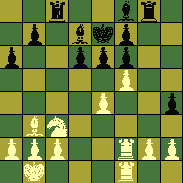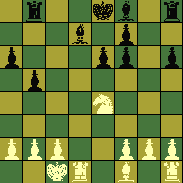
Lecture by UMBC Chess Coach Igor Epshteyn
Double pawns in center - is that strength or weakness ? That is an old positional topic in chess. Same one is pawn sacrifice for positional gain. So, the combination of those positional features to obtain new strategical quality of pawn structure is interesting and powerful plan.
Double pawns in Rauser Sicilian controls important central squares against the invasion of White knights. Black often converts this play in complex endgame that allows them to solve 2 problems: king safety and king activity. Halfopen files 'c' and 'g' are the ways for the rooks. The pawn sacrifice on 'f6' has multiple goals:
The first game of world champion M.Botvinnik was rich in ideas but not perfect in execution. Like it happened in decisive games (Botvinnik needed only victory to reserve 1-st place in the 20-th championship of the USSR), it was nervous and accompanied by reciprocal mistakes. Beautiful positional idea gave to the BLACK (Botvinnik) obvious advantage, but after a few inaccuracies it became unclear is the advantage enough to win the game. Whites mistake before the time control ( 41.Rg1?) gave a weak hope in endgame, where in positional evaluation different color bishops dominated.
Deep and fruitful analysis of adjoined game allowed Botvinnik to create endgame masterpiece. 35 years later Botvinnik's student V.Kramnik managed to create same sort of sacrifice in the same pawn structure against Kamski, but the type of positional advantage gained for the pawn was not exactly the same. Main positional motive was the same - two bishops in (half)open game, but accompanying were: a/time gain(Black pieces were developed and activated using vulnerable position of White pieces), b/Space advantage('c' and 'g' files for the rooks and 'big' diagonals for the bishops),c/ active and safe position of Black king. Black displaced and tied the White pieces in defense of weaknesses, explored it's disharmony in cooperation, then reached full domination on the board.
1. e4 c5
2. Nf3 Nc6
3. d4 cxd4
4. Nxd4 Nf6
5. Nc3 d6
6. Bg5 e6
7. Qd2 h6
8. Bxf6 gxf6
9. 0-0-0 a6
10. f4 Bd7
11. Bc4 h5
12. Kb1 Qb6
13. Rhf1 Qxd4
14. Qxd4 Nxd4
15. Rxd4 Rc8
16. Bb3 Rg8
17. Rd2 h4
18. f5 Ke7
19. Rdf2
Position 1 after White's 19th move:

16. ... Bh6
20. fxe6 fxe6
21. Rxf6 Rcf8
22. Rxf8 Bxf8
23. Rf2 Bh6
24. Bc4 Be3
25. Re2 Bg1
26. g3 hxg3
27. hxg3 Rxg3
28. a3 Be8
29. Ka2 Bh5
30. Re1 Bd4
31. Rh1 Rg5
32. Kb3 Be5
33. Bd3 Bg6
34. Rh4 Rg3
35. a4 Bf6
36. Rh1 Rg4
37. Re1 Be5
38. Nd1 Rf4
39. Nc3 Rf3
40. Nb1 Bg3
41. Rg1 Bxe4
42. Nd2 Bd5
43. Ka3 Rf2
44. Ne4 Bh2
45. Rg6 Bxe4
46. Bxe4 d5
47. Bd3 Be5
48. Rg8 Kd7
49. b4 Bf6
50. Rg1 Rh2
51. Kb3 Kd6
52. Rd1 Ke7
53. c4 Rb2
0-1 after approximately 70 moves
Compare Game 1 with the following game. What is the purpose of Black's pawn sacrifice on move 16? Describe Black's positional gain for this pawn.
1. e4 c5
2. Nf3 Nc6
3. d4 cxd4
4. Nxd4 Nf6
5. Nc3 d6
6. Bg5 e6
7. Qd2 a6
8. 0-0-0 h6
9. Be3 Nxd4
10. Bxd4 b5
11. Qe3 Bd7
12. e5 dxe5
13. Qxe5 Qb8
14. Qxb8 Rxb8
15. Bxf6 gxf6
16. Ne4
Position 2 after White's 16th move:

16. ... Bc6
17. Nxf6 Ke7
18. Nh5 Rg8
19. f3 Rg5
20. Nf4 h5
21. h4 Re5
22. Nd3 Bh6
23. Kb1 Re3
24. Re1 Rg8
25. Rxe3 Bxe3
26. c3 f5
27. Kc2 Kf6
28. Rh3 f4
29. Kd1 e5
30. Ke2 Bd7
31. Rh1 Bf5
32. Kd1 Rd8
33. Kc2 e4
34. fxe4 Bxe4
35. b3 a5
36. a3 b4
37. axb4 axb4
38. cxb4 Rc8
39. Kb2 Bd4
40. Kb1 Ra8
41. Kc1 Ra1
42. Kd2 Ra2
43. Kc1 Be3
44. Kb1 Rd2
45. b5 Rd1
46. Kc2 Rc1
47. Kb2 Bxd3
48. b6 Rxf1
49. b7 Bd4
50. Ka3 Be5
0-1